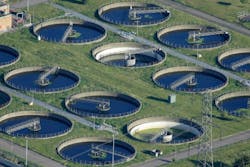Organizations collaborate to release direct potable reuse guidance
ALEXANDRIA, Va. — Sept. 14, 2015 — WateReuse, the American Water Works Association (AWWA) and the Water Environment Federation (WEF) worked together to provide a framework for converting wastewater to drinking water, according to a press release.
As director potable reuse (DPR) continues to grow, "Framework for Direct Potable Reuse" is designed to help state regulatory agencies and utilities develop guidelines to safely use the process, noted the release. Current regulations do not consider today’s technologies that are used in DPR. The process includes technologies such as membranes, reverse osmosis and advanced oxidation.
"The water sector is transforming wastewater treatment into full resource recovery that provides valuable, renewable products," said WEF Executive Director Eileen O’Neill in the release. "This framework will help communities properly vet and consider incorporating DPR into their overall water management strategy."
Seven experts with water and wastewater treatment backgrounds prepared the document. George Tchobanoglous, professor emeritus of civil and environmental engineering at the University of California, Davis, chaired the panel, stated the release. An independent advisory panel from the National Water Research Institute supported the process.
"Until guidelines and regulations are prepared, this framework document can serve as a valuable resource to municipalities, utilities, and agencies interested in implementing DPR programs to augment community water supplies," explained Melissa Meeker, executive director of the WateReuse Association and Research Foundation, in the release.
The framework considers three essential components of a DPR program:
- Regulatory considerations (e.g., measures to mitigate public health risks)
- Technical issues related to the production of advanced treated water
- Public support and outreach
"Freshwater resources are increasingly at risk in many communities," added David LaFrance, CEO of AWWA, in the release. "With many communities seeking to expand their water supply portfolios, this guidance will help ensure that DPR is a safe and viable option."
You can find the entire release here.
